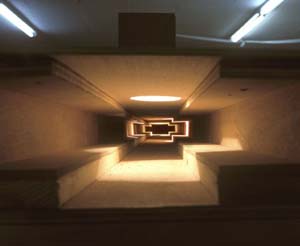Adar Bechar is known for her concern with spaces. In Perfect Childhood, featured at Tel Aviv Museum’s Helena Rubinstein Pavilion on 1993, still remembered as an ambitious, breathtaking installation, she flooded one of the museum halls with water. In the current show she continues her engagement with miniature construction that began several years ago. She creates a giant miniature that simulates the landscape of architectural structures for the viewer peeking in.
The miniature (11 meters width and 4.25 meters depth) “cuts” the museum space at eye level. Before the viewer’s eyes, through peepholes, the expanses of a deserted city are unfolded, alluding to architectural structures such as underground parking lots, corridors, billboards and backyards. Systems of movement and light that operate within the work create a sense of “life,” even though there is no sign of the events taking place inside the work. The motion of light within the installation sustains a fixed and monotonous rhythm that empties “life” of its content. The atmosphere created by the imaginary landscape within the miniature is apocalyptic – as though extracted from powerful cinematic horror scenes. Adar Bechar’s major concern is with questions of sight and seeing. The work oscillates between the desire to offer a convincing apocalyptic scene and the desire to repeatedly interfere with the tendency of being drawn into the illusive dimension, via light manipulations such as flickering and dazzling that interrupt the act of observation.
Less Reading...
